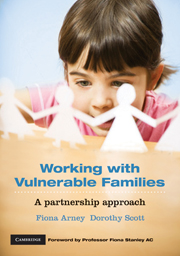Book contents
- Frontmatter
- Foreword
- Contents
- List of figures, tables and boxes
- Contributors
- Acknowledgements
- Introduction
- Chapter 1 Think child, think family, think community
- Chapter 2 Family strengths: an international perspective
- Chapter 3 Harnessing ‘resilience’ when working with children and families
- Chapter 4 Working within and between organisations
- Chapter 5 Family-centred practice in early childhood settings
- Chapter 6 Sustained nurse home visiting with families of Aboriginal children
- Chapter 7 Including fathers in work with vulnerable families
- Chapter 8 Parenting in a new culture: working with refugee families
- Chapter 9 Responding to parents with complex needs who are involved with statutory child protection services
- Chapter 10 Engaging family members in decision making in child welfare contexts
- Chapter 11 Supporting parents whose children are in out-of-home care
- Chapter 12 Using evidence-informed practice to support vulnerable families
- Chapter 13 Spreading promising ideas and innovations in child and family services
- Index
Chapter 4 - Working within and between organisations
- Frontmatter
- Foreword
- Contents
- List of figures, tables and boxes
- Contributors
- Acknowledgements
- Introduction
- Chapter 1 Think child, think family, think community
- Chapter 2 Family strengths: an international perspective
- Chapter 3 Harnessing ‘resilience’ when working with children and families
- Chapter 4 Working within and between organisations
- Chapter 5 Family-centred practice in early childhood settings
- Chapter 6 Sustained nurse home visiting with families of Aboriginal children
- Chapter 7 Including fathers in work with vulnerable families
- Chapter 8 Parenting in a new culture: working with refugee families
- Chapter 9 Responding to parents with complex needs who are involved with statutory child protection services
- Chapter 10 Engaging family members in decision making in child welfare contexts
- Chapter 11 Supporting parents whose children are in out-of-home care
- Chapter 12 Using evidence-informed practice to support vulnerable families
- Chapter 13 Spreading promising ideas and innovations in child and family services
- Index
Summary
Learning goals
This chapter will enable you to:
Understand current policy directions that are supporting more holistic approaches to working with vulnerable families who have multiple and complex needs
Identify the practitioner, organisational and policy related factors which shape practitioner roles
Consider the potential for broadening practitioner roles so that they are more holistic and family centred
Understand the importance of working across professional and organisational boundaries and the factors that influence this
Be able to accept and effectively manage the conflict that can occur in working across professional and organisational boundaries.
Introduction
With the growing realisation that many varied and complex problems, from global warming to crime, infectious diseases and child abuse and neglect, cannot be solved by one service sector or ‘silo’, there is increasing momentum for ‘joined up’ approaches to tackle such issues. In relation to socially marginalised people, overarching ‘social inclusion’ policy frameworks in some countries are focusing attention on how sectors such as health, education, housing, employment and social services can work together more effectively.
This has two main implications for practitioners working with families with multiple and complex needs. One, greater emphasis is being placed on redefining practitioner roles and models of practice so they are more comprehensive. The first part of this chapter therefore explores how practitioner and organisational roles might evolve to respond more holistically to families with multiple and complex needs.
- Type
- Chapter
- Information
- Working with Vulnerable FamiliesA Partnership Approach, pp. 71 - 90Publisher: Cambridge University PressPrint publication year: 2010
- 5
- Cited by



